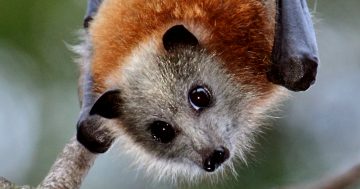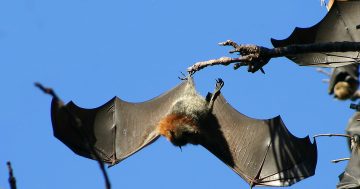
Flying Foxes at Tuross Head. Photo: Bruno Fabbo
Flying-fox numbers in the Eurobodalla and falling as the region turns towards the shorter days and colder temperatures of winter.
Eurobodalla Shire Council’s regular monitoring of the five local Grey-headed Flying-fox camps shows declining numbers typical for this time of year. Council’s Manager of Environmental Services Deb Lenson says flying-foxes are migrating north in search of food and warmer conditions.
“The same trend has been recorded by our colleagues in adjacent shires,” Ms Lenson says.
The Grey-headed Flying-fox is Australia’s largest bat, with a wingspan up to one metre, its presence in the Eurobodalla inspires an appreciation for its place in the environment as well as frustration around noise, odour, and health concerns.
“We have five known camps in the Eurobodalla – Catalina, the Water Gardens at Batemans Bay, Moruya Heads, Tuross Head and Narooma,” Ms Lenson says.
“During monitoring, Council officers assess each camp for population size, footprint, distance to nearby residents, the presence of dependent young, and overall health of the flying foxes.
“We also take note of community concerns and offer advice and assistance where we can.”
The Grey-headed Flying-fox is listed as a vulnerable species and is protected under NSW and federal legislation, a factor that makes population management in an urban environment difficult for local government.
“The arrival of large numbers of flying-foxes in Eurobodalla during summer is linked to the flowering and fruiting of forage trees here. They congregate in large and noisy groups, but the species is declining nationally due to habitat clearing.”
“Across Australia, the camps are increasingly located in urban areas and there is a southward trend. We keep abreast of research and Council contributes to work by CSIRO, state agencies and universities to improve knowledge about flying foxes so we can try and reduce impacts on residents.”
Ms Lenson says the bats are important pollinators that helped keep forests healthy.
“They disperse the seeds of many important tree species. A single flying fox can travel up to 50 kilometres from its camp and disperse up to 60,000 seeds in a single night.”
“Council will continue to offer support to residents affected by flying foxes, understanding that the animals return annually and their movements and patterns are unpredictable.”
Check Council’s website for details of the Eurobodalla Flying-Fox Management Plan.









